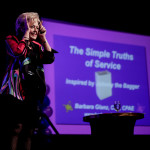Writing A Compelling Book Proposal:
A Critical Moment In The Publishing Adventure
One of the ongoing debates for professional speakers is whether to self-publish or to try to get one’s book published by a mainstream publisher. Before you read any further, you must know that I have a personal bias. All eleven of my books (and several upcoming projects) have been published by well-known publishers, and I feel strongly that part of the rapid growth of my speaking career is due to the credibility that has given me. I have never had an agent, all of my books have sold well above the 10,000 copies publishers seem to use to determine a successful book, and I have also made some money!
Let me tell you a little bit about my experience. Not all of it may work for you, but at least you can learn how one speaker/author achieved publishing success without committing hari-kari! My first book, The Creative Communicator–399 Ways to Communicate Commitment Without Boring People to Death (Tip: Don’t be afraid of long titles–just make them memorable), started out as a small 16 page booklet I did as a handout for a speech I was giving at an executive conference as Director of Quality in Training in a Times Mirror company. As I was working on the booklet, I decided that the whole concept would make a wonderful book. (Tip: Always be thinking of how you can leverage the material you already have.)
I had heard many good things about Irwin Professional Publishing (now part of McGraw-Hill), they were located in the Chicago area, and they were also a Times Mirror company. After researching the name of the senior editor of their business book division, I called him and shared my idea with him. Although he was surprised I got through (Tip: Always make friends with gatekeepers and use names of mutual contacts.), he had a good sense of humor, liked my idea, and after the receipt of a creative written proposal and several meetings when we were both attending other conferences in the next three months, I had a check and a contract. The book was published in 1993. A fun aside–Jack Canfield and I sat next to each other at NSA that year and traded copies of our new books. That was when all the publishers had rejected Chicken Soup for the Soul!
Because the book did very well (Tip: The average business book only sells 3000 copies, so if you do much better than this, you are a hero!), another division of Irwin called and asked me if I would do a book for their new Business Skills Express series. Thus, after a written proposal and some negotiation, Building Customer Loyalty – How YOU Can Help Keep Customers Returning, was published in 1994. It has been the best-selling book in the series and was fun and easy to write. One of the reasons this contact came about was that I made it my business to get to know many of the people at Irwin. I offered to speak to the whole company on the topic of my first book and helped them implement some of the ideas to improve their communication and customer service, so when they needed a SME, they thought of me (Tip: Always make friends with as many people in the publishing company as possible. Visibility and good relationships will help them want to sell your book and will keep you in their mind for future projects.)
When I began formulating the idea for my “heart” book, CARE Packages for the Workplace–Dozens of Little Things You Can Do to Regenerate Spirit at Work, I shared the idea with a woman whom I met in the ladies’ washroom at the 1995 ASTD convention in Anaheim, California, since I had been speaking on the same topic. She immediately replied, “You have to meet my boss. He is very interested in that topic.” (Tip: Network with anyone anywhere on your chosen topic. You never know what may happen!)
When I returned to my room that evening, there was a message from her saying that she and her boss wanted to have lunch with me the next afternoon. That “boss” turned out to be Ken Blanchard! Not only did he use my “Johnny” story which is the signature story on which the book idea was based (Tip: Try to think of an experience or story which exemplifies in a heart-touching way the message of your book. Readers–and editors–will never forget a story!) to close his speech to the entire convention of 11,000 people, but he also called several weeks later and asked if he could write the foreword to the book because of his belief in me and the topic.
With this book I decided that I wanted to pursue an even bigger publisher and by now, I had a good track record to show them. I began to talk with some of my author friends, including Ken, asking them about their editors (Tip: A good editor with whom you have rapport, who will challenge you to stretch, and who will fight for your ideas is crucial to the success of any book). When the same name came up more than once, I decided to focus my efforts on this gentleman and his company, McGraw-Hill.
I called him, shared my idea, and he asked for a proposal. (Tip: Add something creative to your proposal to get the editor’s attention.) Because the whole book idea was based on the metaphor of CARE packages and the acronym CARE, I included in the proposal several 1″ by 2″ brown cardboard boxes with the letters “CARE” and my name and number stamped on them to look just like the CARE packages from WWII. I wrote that I intended to give one of these to every audience member when I spoke on the topic. The editor loved the idea, gave them out at McGraw-Hill’s sales conference when he introduced the book, and the salespeople even gave these little packages to the bookstores when they talked about the book! I also included a number of current articles emphasizing the need for my topic. (Tip: Subscribe to the Wall Street Journal and comb it each day for articles that relate to your topic area.) In two months I had a check and a book contract.
To those of you who have sent out 30 or 40 proposals, I know my experience may sound “too easy to be true;” however, besides the pre-research and networking I did, I had solid, marketable ideas, and most importantly, I wrote a dynamite proposal. (Tip: Study proposals that sold books. Read Write the Perfect Book Proposal by Jeff Herman and Deborah M. Adams.) The sidebar page includes the elements of most book proposals I have seen, and to date, I have worked with five different major publishing companies.
The two most important sections, in my opinion, are “Competition”and “Promotion.” Publishers love speakers! In fact, Barbara Glanz Communications, Inc., is one of the publisher’s best customers. (Tip: As you’re negotiating your contract, you may be able to receive a larger than the usual 40% discount if you guarantee that you will purchase a certain number of books in the first year.) Share how many presentations you give each year, your client list, articles you have had published or copies of interviews and articles in which you were quoted, creative marketing ideas for the book, spinoff products you have in mind, media contacts you have, and any other ideas that will assure the publisher that YOU will be the primary marketer and seller of this book. (Tip: If you can tie your book in with a non-profit organization, both they, you, and the publisher will benefit.) I decided to donate a portion of all my royalties to the CARE organization which was delighted to allow me to use their copyrighted name as a result.
Spend lots of time in bookstores studying books on your subject and devour catalogs to determine exactly what your competition is. (Tip: Also notice which publishing companies published the books which have similar subject matter to yours. That will help you target the publishers most likely to want your book.) Then decide how your book will be different from what is already out there and leverage that difference throughout the book. I created an acronym from a metaphor that was already well-known and then used hundreds of ideas that real organizations are using in their workplaces to stimulate creativity and commitment in readers. This is the most critical part of your proposal. If you have a great idea that is a little DIFFERENT from everything else that has been written on a topic that is of vital interest to a particular market, you have a wonderful chance of having a publisher pick up your book.
Above all, have a passion for your topic. Believe in the message you are sharing, and make sure your life and work authenticate your message. When an editor feels your passion and commitment to a distinctive, marketable idea, he or she will relish giving you a contract, and you will both succeed. Remember, it is an editor’s job to find good material. You already have great ideas. Just begin by doing your research and networking and then writing a “knock your socks off” proposal that the publisher can’t resist. You CAN do it!
BOOK PROPOSAL STRUCTURE — REQUIRED SECTIONS
BOOK CONCEPT
An overview describing the book. Written in succinct, objective terms. Gives the “what” and “why.” The “what” covers the primary concept and scope of the book. The “why” gives the background of what’s happening in the marketplace that creates the need for the book. Specify the length of the manuscript (number of words), describe illustrations and/or photographs, and give projected date of completion. 1-2 pages.
PURPOSE
States the main purpose or theme of the book in one or two sentences. When someone asks you, “What is your book about?”, readily and succinctly answer. Learning to speak and write in sound bites will impress the media as well!
MARKET
Describes the audience for the book. Be as specific as possible. Avoid broad generalizations. Give numbers of potential book buyers if possible. 1 page.
COMPETITION
List competitive books (books someone might buy instead of yours) and state how your book is different and better. Avoid being overly critical of other books. Answer the question: “Why should there be another book on the market?” 1-2 pages.
CONTENT SUMMARY
Give table of contents. I recommend that you have at least 10 chapters and use titles and subtitles. The title should be informal or catchy and the subtitle descriptive. Polish the chapter titles and subtitles–they are key selling points. Table of contents is the “make or break” part of retail book sale. 1-2 pages.
CHAPTER SUMMARIES
Give a short summary of each chapter. Usually one or two paragraphs (1/4 to 1/2 page) but can be as long as one page per chapter. 3 to 10 pages or more. Many publishers will also ask for a sample chapter or two as well to demonstrate your writing style.
AUTHOR
Your qualifications and experience that enable you to write the book. List previous publications and advantages that you have as an author (contacts, resources, research data, personal experiences, etc.). Include who you know, how many you can sell, how you are going to help sell this book. Usually 1 page.
PROMOTION
List all the means you have and are willing to use to assist the publisher to promote and sell the book. Examples are presenting workshops or classes, making presentations at regional and national conventions, writing magazine or journal articles, appearing on radio or TV, etc. Usually 1 page.
OPTIONAL SECTIONS:
COMMENTS FROM READERS
If others have read the proposal and have favorable comments, their comments may be good selling points. Review comments from “name” people and “name” organizations are most valuable. Construct this section so that it reads like book jacket copy. If you have speaker contacts and clients who are willing to provide a testimonial for the book when completed, include their names here. Usually 1-2 pages.
RESEARCH METHODOLOGY
If your book is based on research, it may be helpful to provide more information about your techniques and methods. New research can be the most powerful selling point.
SAMPLE OF WRITING
If you have a good, short article that has been published recently (especially one that covers the same topic), include it as a sample of your writing style.
SUPPORTIVE MATERIAL
If you have short newspaper or magazine clippings that describe what is going on in the market that creates a need for the book, they may be good selling points.
Additional Resources:
Books and Articles
How to Write a Book Proposal–Michael Larsen, Writer’s Digest Books
Write the Perfect Book Proposal--Jeff Herman and Deborah M. Adams
How to Get Happily Published –Judith Appelbaum
“How to Write an Irresistible Book Proposal,” Bud Gardner, Professional Speaker magazine, July 1994
Books in Print
The Writer’s Market
Publisher’s Weekly
Literary Market Place
NSA Directory of Learning Resources
Suggested Conferences and Workshops
Publisher’s University sponsored by Publishers Marketing Association, 310-372-2732
Maui Writers Conference, P. O. Box 968, Kihei, Maui, Hawaii, 800-879-0061
© Barbara Glanz Communications. All Rights Reserved.
Barbara Glanz Biography
A member of the prestigious Speaker Hall of Fame and one of fewer than 700 Certified Speaking Professionals worldwide, Barbara Glanz, CSP, CPAE, works with organizations to improve morale, retention and service and with people who want to rediscover the joy in their work and in their lives. She is the first speaker on record to have spoken on all 7 continents and in all 50 states. Known as "the business speaker who speaks to your heart as well as to your head," Barbara is the author of twelve books including The Simple Truths of Service Inspired by Johnny the Bagger®, CARE Packages for the Workplace, and 180 Ways to Spread Contagious Enthusiasm™. Voted "best keynote presenter you have heard or used" by Meetings & Conventions Magazine, Barbara uses her Master’s degree in Adult Learning to design programs that cause behavior change. She lives and breathes her personal motto: “Spreading Contagious Enthusiasm™” and can be reached at bglanz@barbaraglanz.com and www.barbaraglanz.com.




